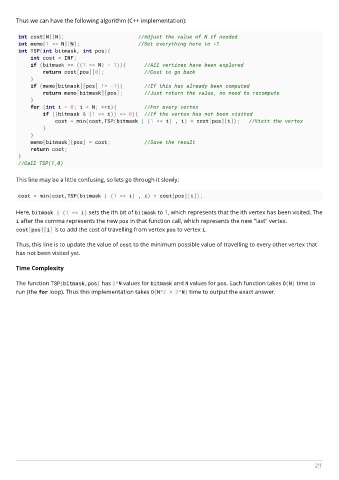Page 215 - Algorithms Notes for Professionals
P. 215
Thus we can have the following algorithm (C++ implementation):
int cost[N][N]; //Adjust the value of N if needed
int memo[1 << N][N]; //Set everything here to -1
int TSP(int bitmask, int pos){
int cost = INF;
if (bitmask == ((1 << N) - 1)){ //All vertices have been explored
return cost[pos][0]; //Cost to go back
}
if (memo[bitmask][pos] != -1){ //If this has already been computed
return memo[bitmask][pos]; //Just return the value, no need to recompute
}
for (int i = 0; i < N; ++i){ //For every vertex
if ((bitmask & (1 << i)) == 0){ //If the vertex has not been visited
cost = min(cost,TSP(bitmask | (1 << i) , i) + cost[pos][i]); //Visit the vertex
}
}
memo[bitmask][pos] = cost; //Save the result
return cost;
}
//Call TSP(1,0)
This line may be a little confusing, so lets go through it slowly:
cost = min(cost,TSP(bitmask | (1 << i) , i) + cost[pos][i]);
Here, bitmask | (1 << i) sets the ith bit of bitmask to 1, which represents that the ith vertex has been visited. The
i after the comma represents the new pos in that function call, which represents the new "last" vertex.
cost[pos][i] is to add the cost of travelling from vertex pos to vertex i.
Thus, this line is to update the value of cost to the minimum possible value of travelling to every other vertex that
has not been visited yet.
Time Complexity
The function TSP(bitmask,pos) has 2^N values for bitmask and N values for pos. Each function takes O(N) time to
run (the for loop). Thus this implementation takes O(N^2 * 2^N) time to output the exact answer.
colegiohispanomexicano.net – Algorithms Notes 211

